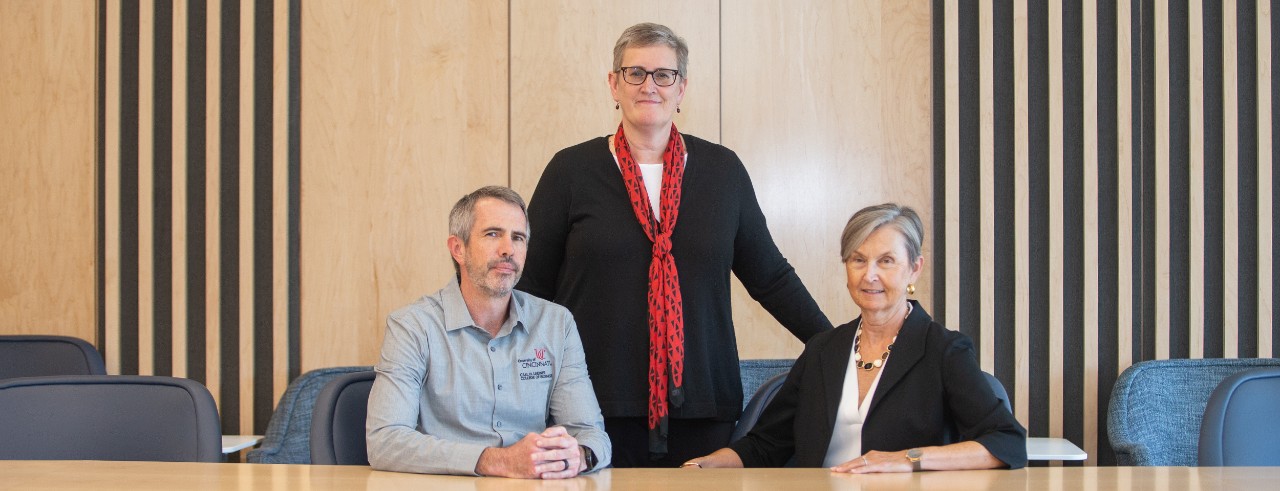
The future of work: What’s the future of in-person work?
UC business professors discuss benefits of being together, how offices are evolving
While office buildings traditionally have been at the center of work for many people, factors including the COVID-19 pandemic have forced employers to reconsider the look of their workspaces.
Three professors from the University of Cincinnati's Carl H. Lindner College of Business discuss the state of in-person work, what’s lost when workers aren’t together in a physical space and how employers are adapting their workspaces to modern needs.
The professors are:
- Michael Fry, PhD, professor of operations, business analytics and information systems and academic director of the Center for Business Analytics
- Suzanne Masterson, PhD, associate dean, Faculty, Research & Lindner Culture, and professor, Department of Management
- Jane Sojka, PhD, professor-educator and marketing undergraduate program director, Department of Marketing
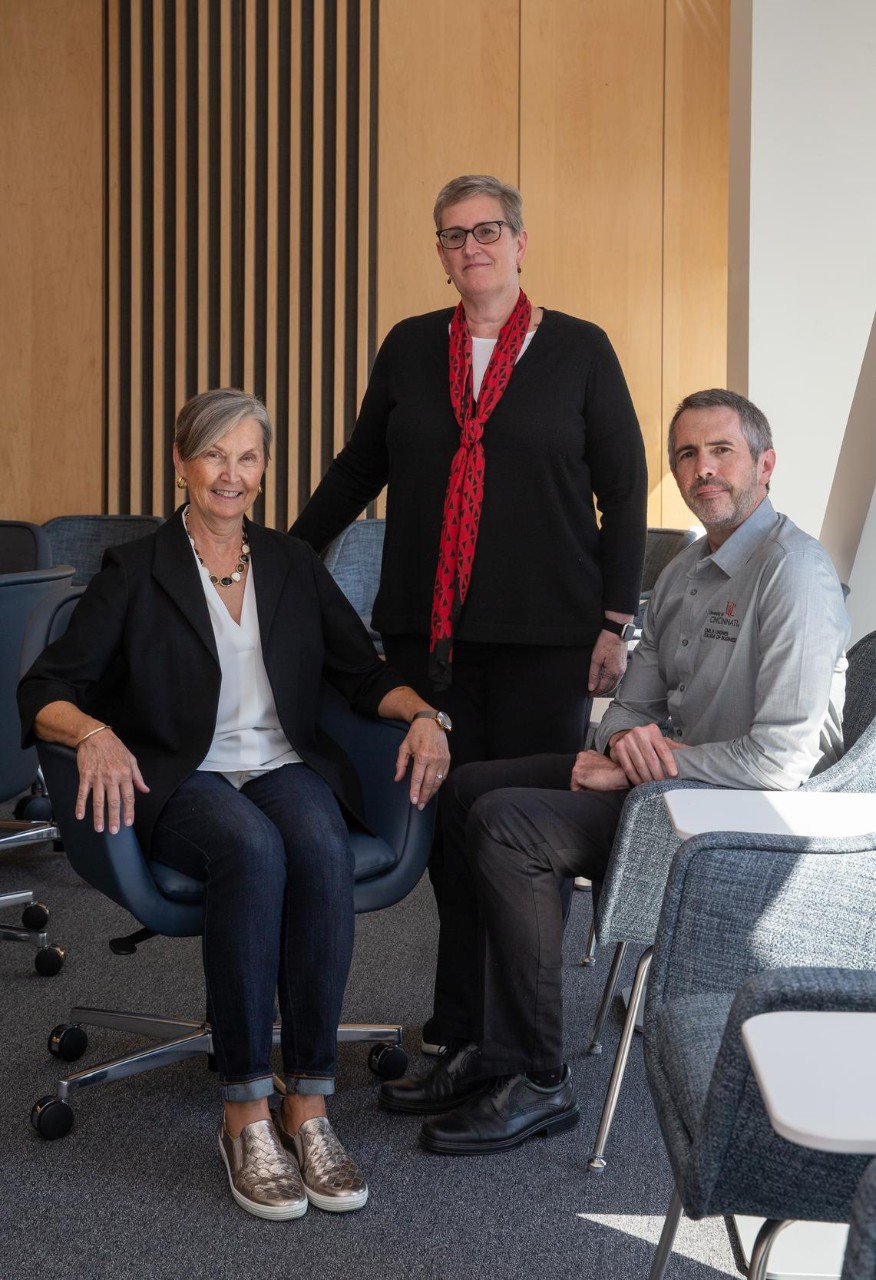
From left, Jane Sojka, Suzanne Masterson and Michael Fry.
What is the value of in-person work and face-to-face interactions?
Masterson: There’s a lot of value in collaboration opportunities and building relationships. When we talk about people working together in person, we think about all the chance encounters that people can have in the workplace, just running into each other, building relationships outside of the typical line of command or organizational chart.
There are also a lot of opportunities for shared information that aren’t always intentional. By talking to people without always having a purpose, or being in meetings with people where there are some other side conversations going on, sometimes a side benefit is we hear some information that maybe wasn’t being given to us directly but directly impacts our work, helping us be more productive or enabling us to add ideas to that other conversation.
Sojka: It’s the energy of having people in the room and the enthusiasm in the building. It’s contagious. You can’t get that over the internet.
What types of jobs benefit most from in-person interactions?
Masterson: When you have work that brings together different disciplines and different ideas, or when you’ve got work that requires collaboration and creativity, those are the types of jobs where it really helps to have interpersonal connections and face-to-face interactions. When you’re trying to have collaboration or brainstorm, it can be more difficult in a virtual or hybrid setting because it’s harder to know when to take turns. It’s harder to build on each other’s ideas. It’s harder to see the nuances and facial expressions and pay attention to all the cues people are giving.
When you’ve got people together around a table, in a space face-to-face, there’s a lot of that sharing and additional communication that goes on beyond just the verbal message. When you think about those kinds of tasks that require collaboration, creativity or coming to a decision where there are a lot of conflicting ideas, it really helps to be in person.
Sojka: In sales, it is our bread and butter to be in front of people because the whole point is building a trusting relationship, and you do that face to face. In fact, there was a piece of research I saw early on with COVID, and it said if you even had a small face-to-face encounter, like coffee for half an hour, it’s easier to build up a trusting relationship online than with none at all.
Masterson: When we think about grocery stores and restaurants that did a lot of delivery and takeout during the pandemic, they still had to have people working, stocking the shelves, filling the orders, cooking the food. There are a lot of different kinds of jobs in which it would be impossible to only work from home. And, unfortunately, a lot of those jobs are undervalued because it seems like they’re easy jobs or they don’t need as much education or skill requirements, but they’re vital to the economy. We really saw that during the pandemic. We put a lot of emphasis on knowledge (white-collar) jobs and technology jobs, and those are important jobs, but it’s an apples and oranges comparison.
Think about the kinds of jobs and industries and organizations that are the backbone of keeping the services that all those other folks need — grocery stores, restaurants, services, auto mechanics. All those types of things are important to keep everything going.
What’s lost when workers aren’t together in person?

Jane Sojka, PhD, professor-educator and marketing undergraduate program director, Department of Marketing
Sojka: I think it’s harder to build a trusting relationship because all I can see is your face. I can’t shake your hand. You don’t have a lot of cues. Credibility is 58% body language, 35% how you say it, and only 7% is what you say. That comes from Fran Hauser’s book, “The Myth of the Nice Girl.” Conversely, companies were happy because they saved a ton of money [during the pandemic] on travel. Especially if they were customers they had already worked with — we’ve built a trusting relationship, we’ve gone to dinner, we know each other — and then you switch it over to online, that is much easier. If it was an already existing relationship, no big deal. I already know who you are. But brand new, it’s tougher.
Fry: What I think we may see is that there are less opportunities for what's sometimes called serendipity. So, if I'm in analytics, you're a journalism professor, and we just happen to show up at lunch one day, and you happen to mention that you've been trying to find a specific data set. And I'm like, “Oh, I know that.” Right? But in an online environment, that doesn't happen. It's going to be tough to measure these things, but I do think there may be some loss of creativity just because we don't have these accidental interactions where we're just chatting and it turns out we've got a common interest — that would not come out on a [Microsoft] Teams meeting where we've scheduled A, B and C.
Masterson: One of the biggest advantages of being in person is just the ability to see people consistently, see them across different situations and run into them both purposefully and incidentally. Those are the kind of encounters that build stronger relationships in the workplace, a stronger sense of belonging, a stronger sense of trust and more willingness to be yourself in the workplace. I don’t think that requires 100% time in the office, but it does require some level of investment in being there and having those kinds of encounters.
Sojka: I think the pandemic was really hard emotionally on sales people. It’s one thing if you’re in data analytics, and your job is spending time in front of a computer. Sales people are “people people.” They love their customers. They took care of their customers. They enjoyed seeing their customers. It was really hard to not be able to get in front of their customers and have lunch. I know the ones I’ve talked to have been very glad that things are opening up.
Sales reps are used to wining and dining, building relationships, getting in front of the customers. And all of a sudden, in many cases, you’re presenting to a blank screen. We’re used to being in front of people, so you can read their reactions, you can read their body language. If you’re on the internet, and people have shut their screens off, you can’t even read the body language. One sales rep described it as talking to crickets. You have no clue. I think that was really hard from a business perspective. Of course, they learned how to do it. Companies are all doing fine. Sales reps I’m in touch with are all doing fine. They adapted, but I think emotionally it was very hard.
Masterson: Workplaces are one of the only places we really encounter people who are different from us. If we’re religious, we tend to go to church or synagogue or the mosque with people who are like us. We tend to live in neighborhoods with people like us. We tend to end up in a lot of different situations with people who are like us. And whether it’s diversity of thought, disciplines or of ethnicities and religions, the workplace is one of the key places where we encounter people who are different from us in a meaningful way. And I worry that as we lose that, we become more isolated from people who are different from us. We’re not as exposed to new ideas and different ways of thinking, and I think that’s a big loss.
I worry that the more we become isolated working at home, the more we become rigid in “us versus them” thinking. Traditionally, workplaces have been a place where for 40 hours a week, you’re around a lot of different people, you’re exposed to different ideas, you get to trust them in different settings, and it opens people up to different ways of thinking.
While there are benefits of working in person, how do employers balance that with many employees’ desire to work from home?
Fry: I run our Center for Business Analytics where we have 28 companies that are members. They’re all struggling with this. Everybody from P&G and Kroger to Great American and Fifth Third, all of them are trying to figure this out. All of them believe there is value, but there is a trade-off. There’s a value to having happy employees, and they’re finding out that employees are happier if they can spend at least part of their time working remotely.
Sojka: The internet is not going away. What we’ve learned is there is a lot of business that can be done perfectly fine over Zoom, and it’s going to save money. It’s a win-win because the companies don’t have to spend on travel, sales people don’t have to spend time away from home, and the business is conducted. That’s not going away, but you still need to have that personal relationship to conduct the business online.
With increased comfort with remote work, will companies reduce their office space?
Sojka: For sales, a lot of them did away with their offices because, once again, it’s a cost-saving measure. If you’re an enterprise sales rep, you shouldn’t be in the office anyway. You should be with your customer. If you’re either with the customer or working from home, they save money on office space. Particularly for sales, you’re likely to see fewer and fewer office buildings. Even inside sales where you had everybody in a bullpen kind of, even a lot of those they had to go remote, and once they went remote, they realized this is working just fine and cheap. Even those are staying remote.
Masterson: A financial planner I know has moved from office space to office space, and finally just said, “I don’t need this. The pandemic has shown me that I don’t need to spend this kind of money, which enables me to save money and also to save clients money.” In terms of commercial real estate, I think we hear about organizations trying to decide as leases come up, “Do I need all this space? What do I want to do with it?”
Sojka: I don’t think the [business travel segment] is back yet. It’s coming, but now that companies, especially with existing customers — we know you, we don’t need to go to see you every month — those meetings will still be done online. However, the other ones, the wining and dining, and, “Hey, let’s get to know each other. You can trust me.” That kind of thing, I think that’s picking back up again.
For companies that maintain offices, what will they look like?
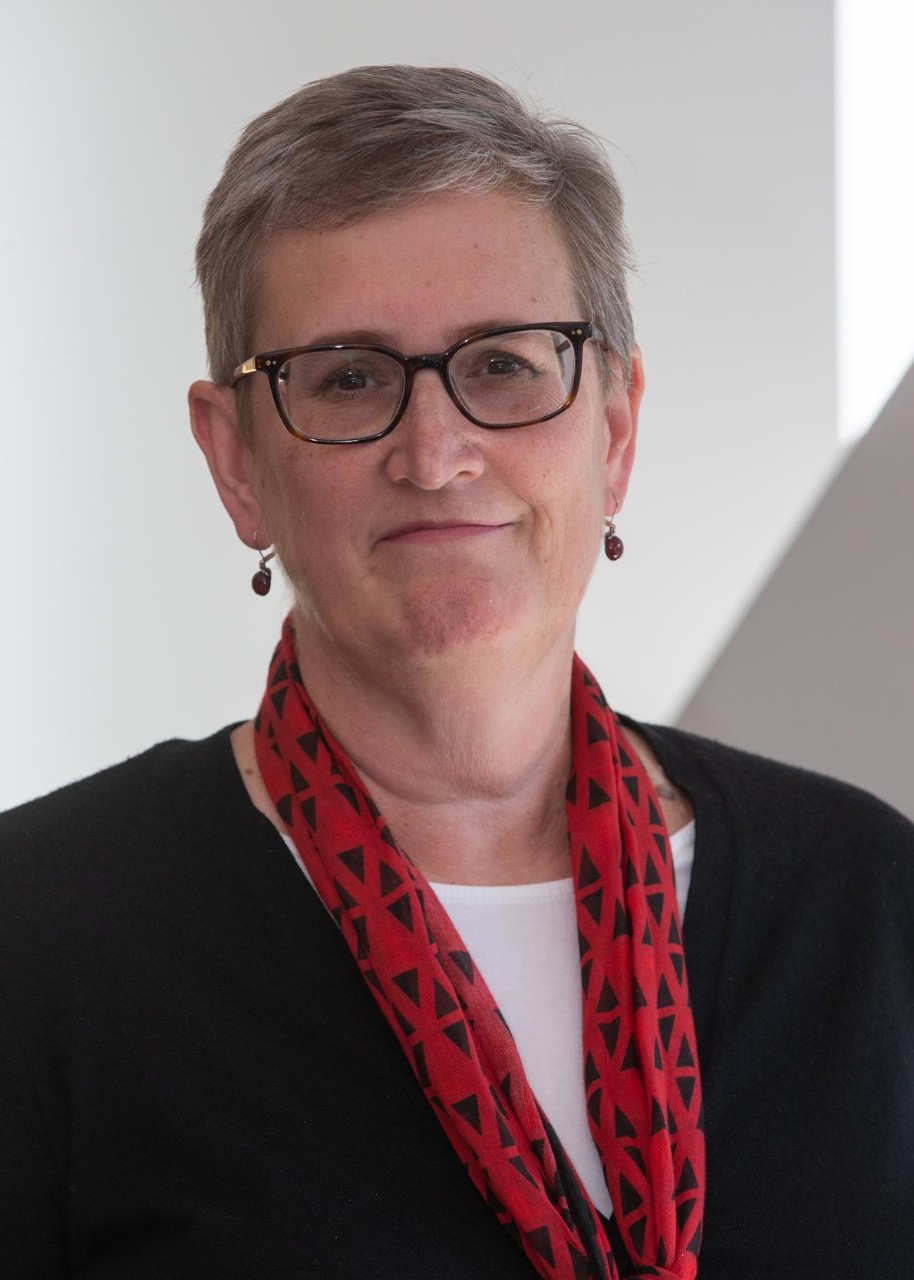
Suzanne Masterson, PhD, associate dean, Faculty, Research & Lindner Culture, and professor, Department of Management
Masterson: I think a lot of it is going to be dependent on the company, what industry it’s in and what its particular needs are. I would hope that we have learned a lot during the pandemic as well as learned from the research coming out about open space versus offices versus cubicles. I think the ideal office space of the future is going to have a number of different configurable spaces in it that can be used for multiple purposes. There will be some private offices, and people who are always in private offices because they are doing “deep-thought work,” and it makes the most sense for them to be there. I think there are going to be more open collaboration spaces where people can congregate throughout the day, they can come out of their private spaces and meet, share ideas and have those spaces built in versus always trying to find a conference room. You’re going to have small gathering spaces, and I think you’re going to have cubicles or open spaces that are “hoteling” where people can come in and work for the day, but they don’t need it five days a week.
Having just done a tour of the [new UC] Digital Futures building, I think that’s an example of a space where they’re trying to do some of that. There are labs and offices, but there’s lots of different kinds of small meeting places, congregating spaces. You see that in our building here in the College of Business as well.
How do employees view open office spaces versus private spaces?
Masterson: Several colleagues and I conducted a study of a group of employees moving from individual cubicles to open-space. One of the things that came out of this study was that the employees were very worried about being able to hear each other’s conversations before they went into this space. Afterward, they said, “You know, it actually turned out to be a positive because there were conversations I was not part of, but when I heard a little bit of it, realized I should be a part of it. I turned around, joined the conversation, and in fact it solved a problem for all of us even more quickly than we would have before.” That’s not going to apply to all work situations, but it is a benefit of having those chance encounters, sharing information and building relationships over time.
There are definitely times and contexts where open space makes a lot of sense. If you have a project team that is working collaboratively, if you have people who are working in agile work environments, a lot of times having everyone in the same space working together, overhearing each other’s ideas, being able to jump up and quickly join a meeting and then go back to work, it is great. But it’s not the only kind of space those folks need. They often need private spaces to go to for their “deep-thought work.” There might be meeting rooms you need for when a subgroup needs to talk and not interrupt the other people in the group.
So open space definitely has some advantages over short periods of time, but to be the only space for a person to work in brings some negatives with it as well. And, as we saw in the pandemic, it’s hard to bring people into an open space when they would have to be masked the whole time or worried about whether they could possibly be infecting each other. So private offices that are able to be closed offer a lot of advantages.
How can employers improve the office environment for their employees?
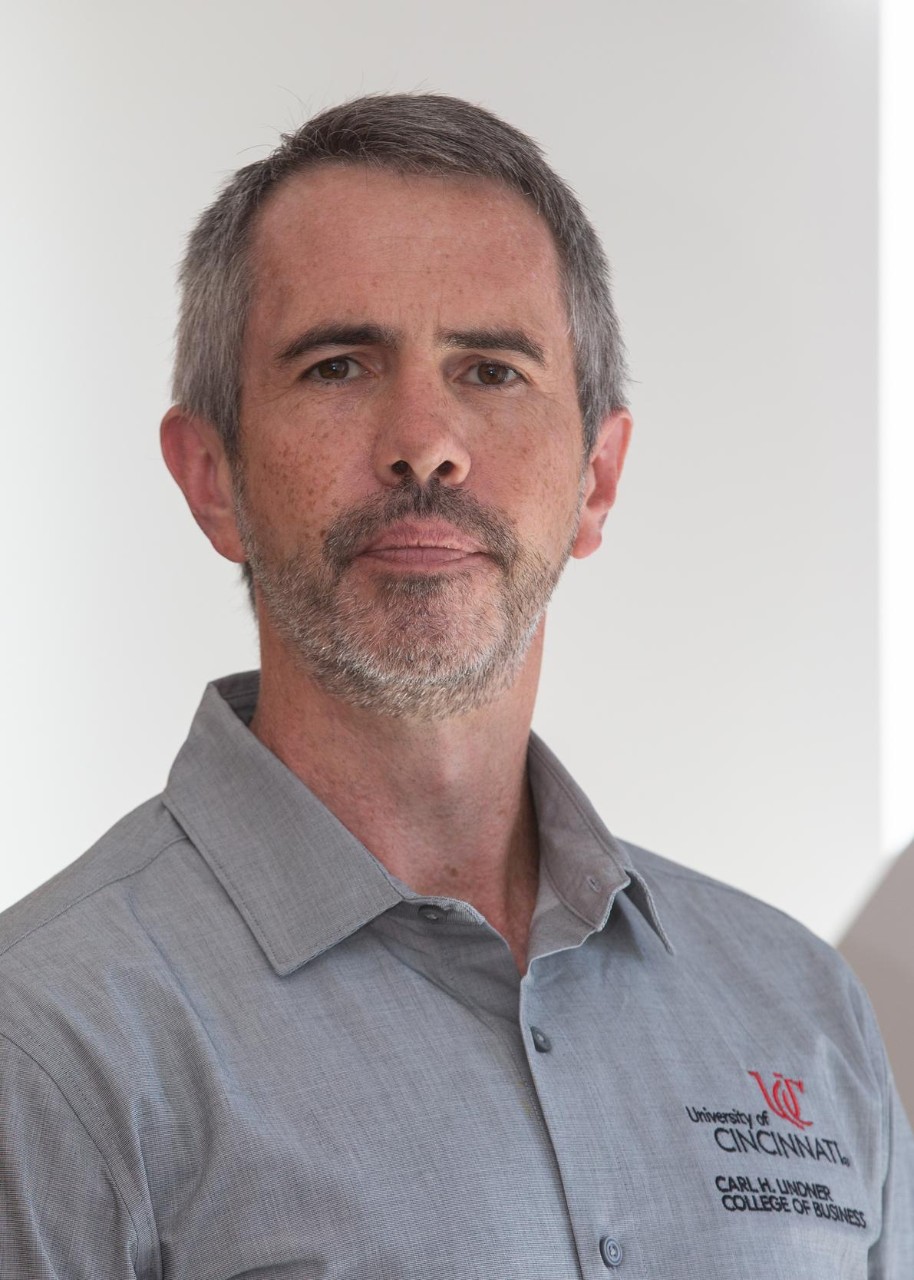
Michael Fry, PhD, professor of operations, business analytics and information systems and academic director of the Center for Business Analytics
Fry: We often try to force the person to the work environment rather than adapting the work environment to the person. Some of the things we’re seeing [in a UC study of work environments] that match some of the hypotheses made by workplace design experts, is that control of your work environment actually matters. Control is something people like. In statistics, there is a concept known as “the flaw of averages.” When you design a system to be comfortable for the “average person,” then that system might not actually meet the preference of any one individual because no one is exactly “average.” And so everyone is unhappy. Most people who have had a significant other know this. If you share a household, somebody likes it warm; somebody likes it cold. If we set the thermostat to 68 degrees, if that’s the average of what we both like, now we’re both unhappy. That’s the challenge. How do we meet those individual preferences in a controlled environment? Also, people like light, but depending on if my desk is oriented this way versus oriented that way, that actually makes a big difference. Those are some things that are fairly easy to change, just where our desk is. If I just turn your desk a little, it may expose you to much more light than a different orientation, and that small change can make a big difference in how you perceive your work environment.
Masterson: One of the things that’s really important to people is being able to make the space their own in terms of identity; all the little tchotchkes people put around, what they put on the walls, the ability to bring in all of your Marvel figurines. In that study we did with a company that was moving a couple of teams to open space, this was something a lot of people talked about before the move; they were in cubicles, and they said, "Look at all my figurines, look at my posters on the wall. Where am I going to put that, and how will my desk be different from anyone else’s? I spend a lot of time working at this desk. I want it to reflect my personality and who I want to be in the workplace.” Not being able to do that was a real concern for them. It really is a big deal for people to be able to express who they are in the workplace, and one of the ways we do that is in what we put into our space, how we decorate it, what we look at while we’re working.
If offices move to a “hoteling” setup, how will that affect employees and their desire to personalize their space?
Masterson: It makes it much more sterile. It makes it less like your space, and it becomes just a space to park for a while. That can work occasionally, just like it can work occasionally to go to Starbucks and sit down and work. But longer term, people like to have ownership over that space; it’s their space. And there have been some qualitative studies that have shown that when you have this “hoteling” space, whoever comes in first, it’s theirs. People will leave markers on that space to try to discourage other people from taking it, even though it’s not assigned. They’ll leave a dirty coffee cup. They’ll leave something in the space that they think other people won’t use so it’s still theirs even though it’s not really theirs.
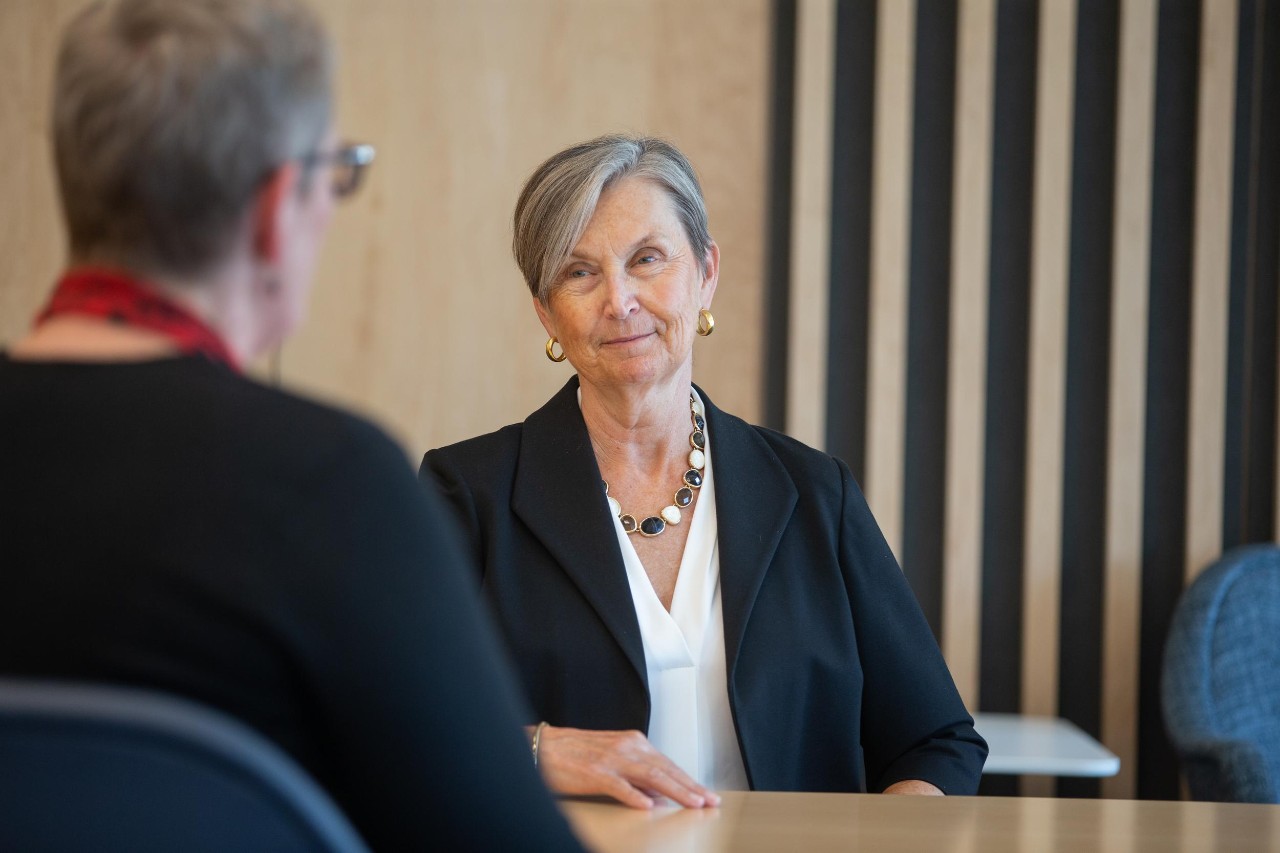
Jane Sojka, right, speaks with Suzanne Masterson.
Today’s students largely have grown up immersed in technology and had reduced in-person interactions during some of their formative years because of the COVID-19 pandemic. How are you preparing them to work in person?
Sojka: Our sales recruiters want face to face, and our students are afraid to go face to face now. They’re used to hiding behind a computer screen. In the pandemic, students are used to hiding behind a screen. They think, “Oh, it’s my resume.” Not in sales. They want to see people. I tell my students, they’re going to fall in love with you, with your smile, with your eye contact, with the way you can start a conversation. And then they’ll say, “Oh, by the way, do you have a resume?” We are really pushing the interpersonal skills and that ability to talk to people face to face. The recruiters want it. The students, they’re just really out of practice.
Masterson: One of the things that we do is to stress the importance of those “soft skills.” Technical skills will get you the job and will get you so far, but when you think about moving into leadership or being a really successful employee, it is the soft skills that matter — being able to act respectfully, to have good communication skills, to build trust with your coworkers, customers and the other people you encounter. Talking about how important those skills are, stressing those skills and building them into our different courses is important for that next phase. They are just as important as the technology if you are going to be working hybrid, because you need to understand how to communicate virtually, how to construct emails, how to manage yourself in a virtual meeting. Both sets of skills are really important, but over time, research has shown that it’s the soft skills that really differentiate people that move up in organizations and into leadership. It’s those “emotional intelligence-type skills.”
Sojka: I’m teaching our students to be fluent in both. Fluent and comfortable in both online and in person.
What other challenges exist as this new generation of employees begins to enter the workforce?
Masterson: Technology has changed the way generations like to communicate overall. It’s going to be interesting to watch. I know a lot of our students who would do almost anything not to have to answer the phone — send me a text, send me an email, Snapchat me, do whatever you want, but don’t call me; I’m not going to pick up the phone. You look at a generation or two above them who say phone conversations are how you reach people, and you leave the voicemail, and you wait for them to call you back. That’s just not the way we communicate anymore. It’s also understanding the differences between generations and looking for how soft skills can be found in new communication strategies or how we interpret those messages. I think we’re still negotiating some of those things when you have multiple generations in the workplace, and they are not necessarily understanding each other completely. The differences are what really lead us to better solutions and better problem solving because we bring lots of different perspectives to the table, and if we’re willing to have meaningful conversations where there can be conflicts about the ideas but not conflict on people, that’s when you can get really creative, innovative solutions that take the best of all the ideas.
What about remote work? UC experts weighed in on that as well.
Featured image at top: From left, Michael Fry, Suzanne Masterson and Jane Sojka. All photos by Andrew Higley/UC Marketing + Brand
Impact Lives Here
The University of Cincinnati is leading public urban universities into a new era of innovation and impact. Our faculty, staff and students are saving lives, changing outcomes and bending the future in our city's direction. Next Lives Here.
Related Stories
UC Business Analytics director named INFORMS fellow
October 9, 2020
Glenn Wegryn, executive director for the Center for Business Analytics at the University of Cincinnati’s Carl H. Lindner College of business, has been named a fellow for The Institute for Operations Research and the Management Sciences (INFORMS), the largest international association of operations research and analytics professionals and students.
Data Science Symposium 2022 touts analytics advances,...
November 17, 2022
A sold-out crowd packed the Carl H. Lindner College of Business last week for Data Science Symposium 2022, which demonstrated advances in data science tools, technologies and methodologies.
